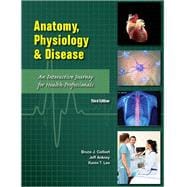This engaging, conversational book introduces all the anatomy, physiology, and pathology concepts that students must master to succeed in the health professions. ANATOMY, PHYSIOLOGY, & DISEASE: AN INTERACTIVE JOURNEY FOR HEALTH PROFESSIONS, 3/e is designed to promote true understanding, not mere memorization, and to help students make the lasting connections they need to thrive as practitioners. Throughout, well-placed "Pathology Connections" sections tightly link A&P concepts to pathologic processes. Analogies help students compare the human body to objects and processes they already understand, and illustrations and visual features support the visual learning style many of them prefer. This edition adds new web-based animations, videos, and interactive exercises to its fully integrated website. It also offers an easier-to-navigate text design; enriched illustrations and new photographs; and a new chapter on biochemistry.
Note: This is just the standalone book.








